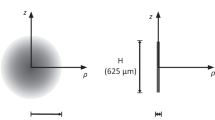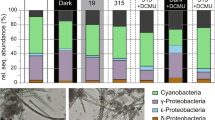Abstract
MARINE species of Thioploca occur over 3,000 km along the continental shelf off Southern Peru and North and Central Chile1–4. These filamentous bacteria live in bundles surrounded by a common sheath and form thick mats on the sea floor under the oxygen-minimum zone in the upwelling region, at between 40 and 280 m water depth. The metabolism of this marine bacterium5,6 remained a mystery until long after its discovery1,7. We report here that Thioploca cells are able to concentrate nitrate to up to 500 mM in a liquid vacuole that occupies >80% of the cell volume. Gliding filaments transport this nitrate 5–10 cm down into the sediment and reduce it, with concomitant oxidation of hydrogen sulphide, thereby coupling the nitrogen and sulphur cycles in the sediment.
This is a preview of subscription content, access via your institution
Access options
Subscribe to this journal
Receive 51 print issues and online access
$199.00 per year
only $3.90 per issue
Buy this article
- Purchase on Springer Link
- Instant access to full article PDF
Prices may be subject to local taxes which are calculated during checkout
Similar content being viewed by others
References
Gallardo, V. A. Nature 286, 331–332 (1977).
Rosenberg, R. et al. J. mar. Res. 41, 263–279 (1983).
Henrichs, S. M. & Farrington, J. W. Limnol. Oceanogr. 29, 1–19 (1984).
McCaffrey, M. A., Farrington, J. W. & Repeta, D. J. Org. Geochem. 14, 61–68 (1989).
Morita, R. Y., Iturriaga, R. & Gallardo, V. A. Kiel. Meeresforsch. Sonderh. 5, 384–389 (1981).
Maier, S. & Gallardo, V. A. Arch. Microbiol. 139, 218–220 (1984).
Gallardo, V. A. Gayana Zool. 10, 3–15 (1963).
Maier, S. & Gallardo, V. A. Int. J. Syst. Bact. 34, 414–418 (1984).
Maier, S., Völker, H., Beese, M. & Gallardo, V. A. Can. J. Microbiol. 36, 438–448 (1990).
Nelson, D. C., Revsbech, N. P. & Jørgensen, B. B. Appl. envir. Microbiol. 52, 161–168 (1986).
Sweerts, J. P. R. A. et al. Nature 344, 762–763 (1990).
Maier, S. & Murray, R. G. E. Can. J. Microbiol. 11, 645–656 (1965).
Jørgensen, B. B. & Revsbech, N. P. Appl. envir. Microbiol. 45, 1261–1270 (1983).
Larkin, J. M. & Strohl, W. R. A. Rev. Microbiol. 37, 341–367 (1983).
Nelson, D. C., Jørgensen, B. B. & Revsbech, N. P. Appl. envir. Microbiol. 52, 225–233 (1986).
Codispoti, L. A. & Christensen, J. P. Mar. Chem. 16, 277–300 (1985).
Codispoti, L. A. et al. Science 233, 1200–1202 (1986).
Author information
Authors and Affiliations
Rights and permissions
About this article
Cite this article
Fossing, H., Gallardo, V., Jørgensen, B. et al. Concentration and transport of nitrate by the mat-forming sulphur bacterium Thioploca. Nature 374, 713–715 (1995). https://doi.org/10.1038/374713a0
Received:
Accepted:
Issue Date:
DOI: https://doi.org/10.1038/374713a0
This article is cited by
-
Simultaneous sulfate and nitrate reduction in coastal sediments
ISME Communications (2023)
-
Fluid flow stimulates chemoautotrophy in hydrothermally influenced coastal sediments
Communications Earth & Environment (2022)
-
Intracellular nitrate storage by diatoms can be an important nitrogen pool in freshwater and marine ecosystems
Communications Earth & Environment (2022)
-
Formation and function of bacterial organelles
Nature Reviews Microbiology (2020)
-
Effect of large magnetotactic bacteria with polyphosphate inclusions on the phosphate profile of the suboxic zone in the Black Sea
The ISME Journal (2019)
Comments
By submitting a comment you agree to abide by our Terms and Community Guidelines. If you find something abusive or that does not comply with our terms or guidelines please flag it as inappropriate.



